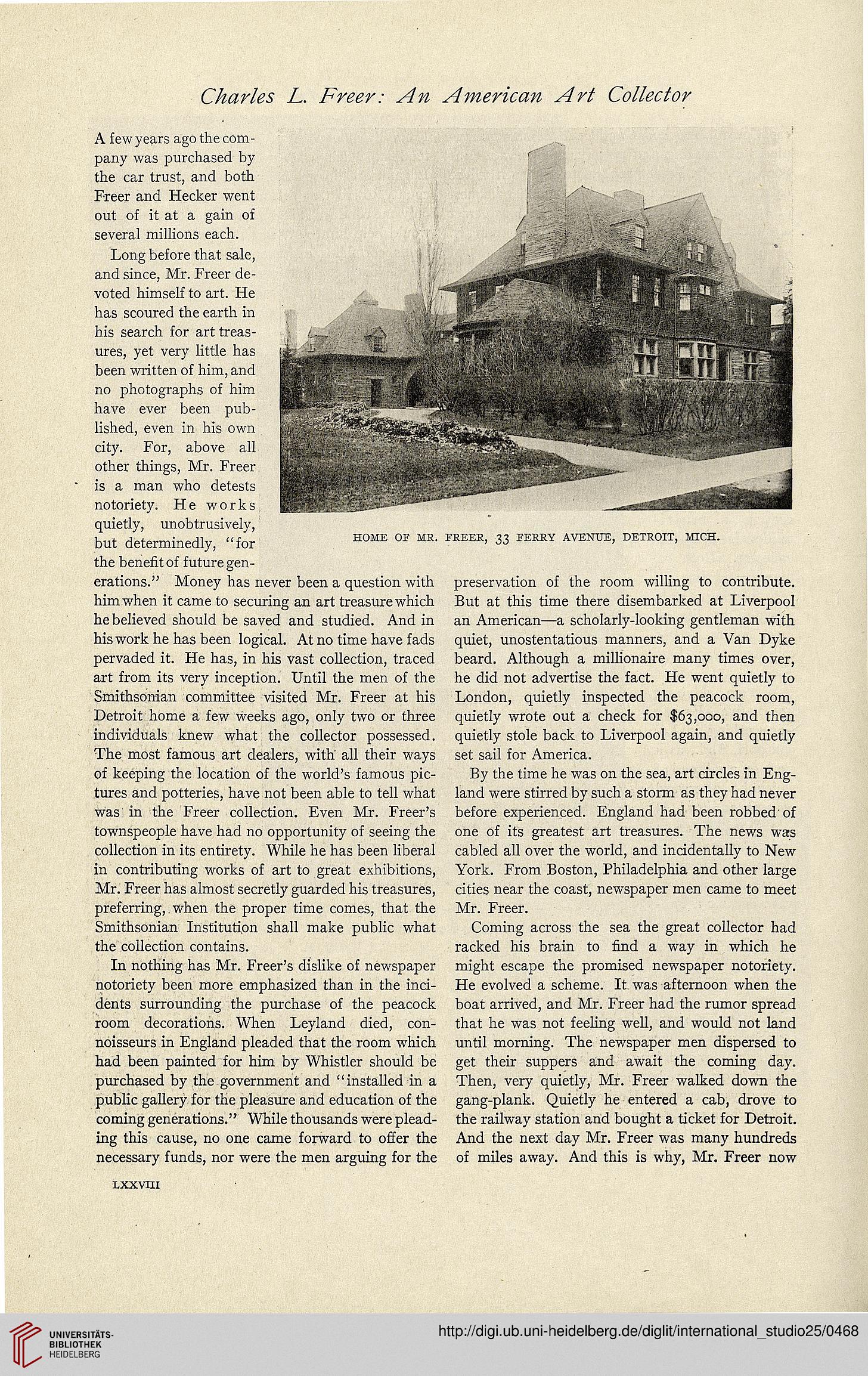HOME OF MR. FREER, 33 FERRY AVENUE, DETROIT, MICH.
A few years ago the com-
pany was purchased by
the car trust, and both
Freer and Hecker went
out of it at a gain of
several millions each.
Long before that sale,
and since, Mr. Freer de-
voted himself to art. He
has scoured the earth in
his search for art treas-
ures, yet very little has
been written of him, and
no photographs of him
have ever been pub-
lished, even in his own
city. For, above all
other things, Mr. Freer
is a man who detests
notoriety. He works
quietly, unobtrusively,
but determinedly, "for
the benefit of future gen-
erations." Money has never been a question with
him when it came to securing an art treasure which
he believed should be saved and studied. And in
his work he has been logical. At no time have fads
pervaded it. He has, in his vast collection, traced
art from its very inception. Until the men of the
Smithsonian committee visited Mr. Freer at his
Detroit home a few weeks ago, only two or three
individuals knew what the collector possessed.
The most famous art dealers, with all their ways
of keeping the location of the world's famous pic-
tures and potteries, have not been able to tell what
was in the Freer collection. Even Mr. Freer's
townspeople have had no opportunity of seeing the
collection in its entirety. While he has been liberal
in contributing works of art to great exhibitions,
Mr. Freer has almost secretly guarded his treasures,
preferring, when the proper time comes, that the
Smithsonian Institution shall make public what
the collection contains.
In nothing has Mr. Freer's dislike of newspaper
notoriety been more emphasized than in the inci-
dents surrounding the purchase of the peacock
room decorations. When Leyland died, con-
noisseurs in England pleaded that the room which
had been painted for him by Whistler should be
purchased by the government and "installed in a
public gallery for the pleasure and education of the
coming generations." While thousands were plead-
ing this cause, no one came forward to oSer the
necessary funds, nor were the men arguing for the
preservation of the room willing to contribute.
But at this time there disembarked at Liverpool
an American—a scholarly-looking gentleman with
quiet, unostentatious manners, and a Van Dyke
beard. Although a millionaire many times over,
he did not advertise the fact. He went quietly to
London, quietly inspected the peacock room,
quietly wrote out a check for $63,000, and then
quietly stole back to Liverpool again, and quietly
set sail for America.
By the time he was on the sea, art circles in Eng-
land were stirred by such a storm as they had never
before experienced. England had been robbed of
one of its greatest art treasures. The news was
cabled all over the world, and incidentally to New
York. From Boston, Philadelphia and other large
cities near the coast, newspaper men came to meet
Mr. Freer.
Coming across the sea the great collector had
racked his brain to find a way in which he
might escape the promised newspaper notoriety.
He evolved a scheme. It was afternoon when the
boat arrived, and Mr. Freer had the rumor spread
that he was not feeling well, and would not land
until morning. The newspaper men dispersed to
get their suppers and await the coming day.
Then, very quietly, Mr. Freer walked down the
gang-plank. Quietly he entered a cab, drove to
the railway station and bought a ticket for Detroit.
And the next day Mr. Freer was many hundreds
of miles away. And this is why, Mr. Freer now
LXXVIII




